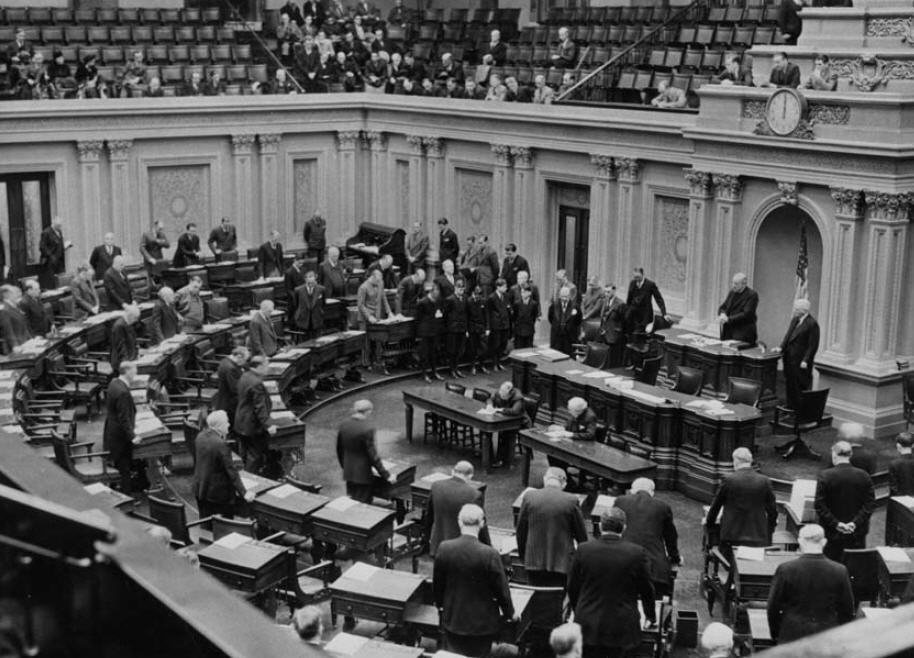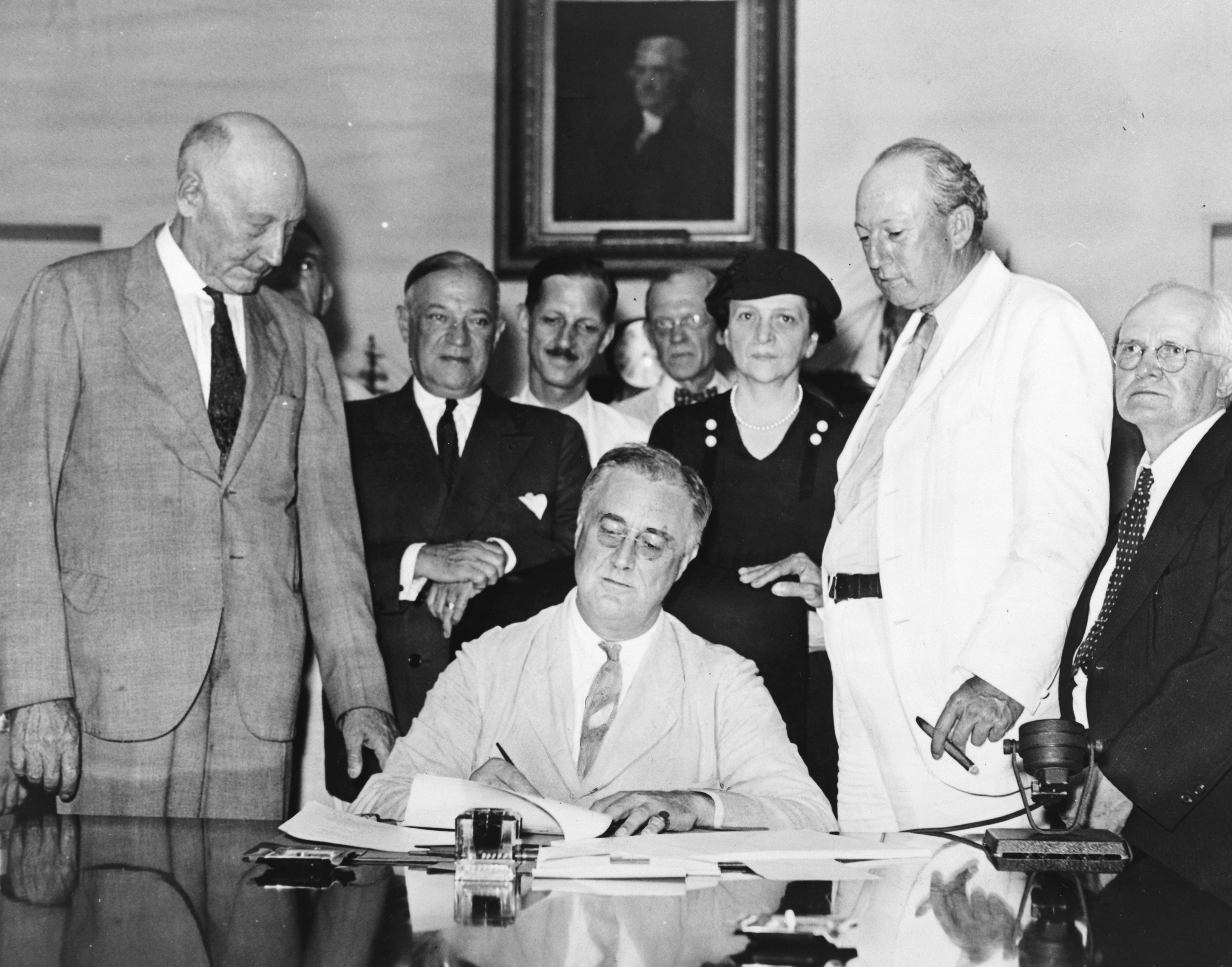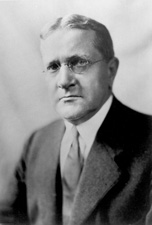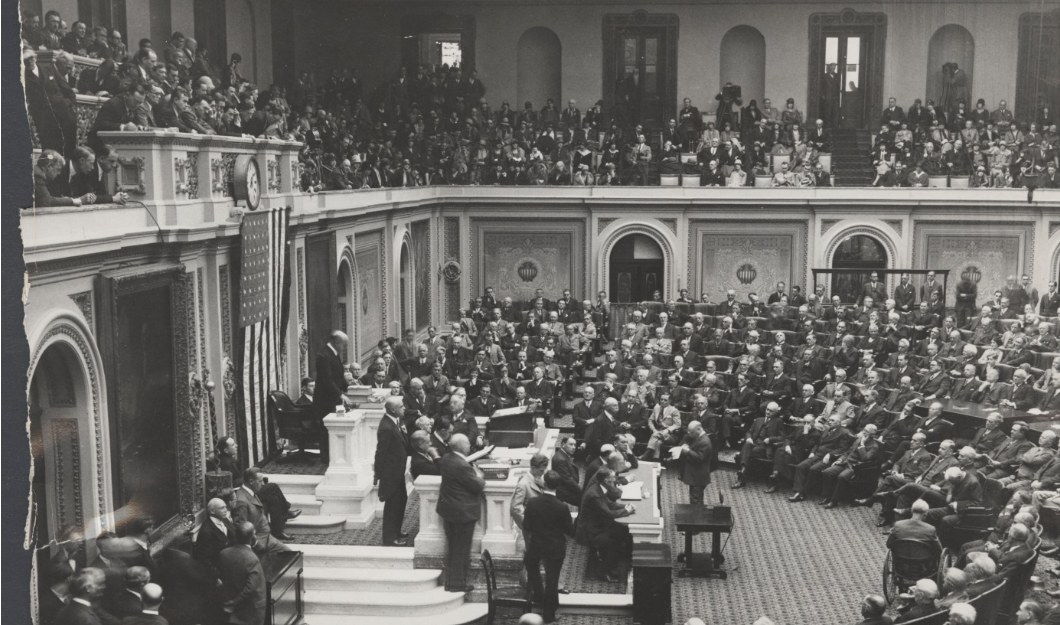|
William I. Sirovich
William Irving Sirovich (March 18, 1882 – December 17, 1939) was an American physician and politician from New York. From 1927 to 1939, he served six terms in the U.S. House of Representatives. Early life Sirovich was born in 1882 in York County, Pennsylvania to Hungarian-Jewish immigrants Jacob and Rose Sirovich (née Weinstock). The family moved to New York City in 1888. Sirovich attended the public schools there and graduated from the College of the City of New York in 1902 and from the Columbia University College of Physicians and Surgeons in 1906. He commenced the practice of medicine in New York City in 1906 and also engaged as a lecturer, editor, and playwright, several of his plays being produced on Broadway. Political career In 1908 and 1910, he ran on the Independence League ticket for New York State Treasurer but was defeated by Republican Thomas B. Dunn (1908) and Democrat John J. Kennedy (1910). He was a member of the fifth district school board from 1906 to ... [...More Info...] [...Related Items...] OR: [Wikipedia] [Google] [Baidu] |
New York (state)
New York, officially the State of New York, is a state in the Northeastern United States. It is often called New York State to distinguish it from its largest city, New York City. With a total area of , New York is the 27th-largest U.S. state by area. With 20.2 million people, it is the fourth-most-populous state in the United States as of 2021, with approximately 44% living in New York City, including 25% of the state's population within Brooklyn and Queens, and another 15% on the remainder of Long Island, the most populous island in the United States. The state is bordered by New Jersey and Pennsylvania to the south, and Connecticut, Massachusetts, and Vermont to the east; it has a maritime border with Rhode Island, east of Long Island, as well as an international border with the Canadian provinces of Quebec to the north and Ontario to the northwest. New York City (NYC) is the most populous city in the United States, and around two-thirds of the state's popul ... [...More Info...] [...Related Items...] OR: [Wikipedia] [Google] [Baidu] |
School Board
A board of education, school committee or school board is the board of directors or board of trustees of a school, local school district or an equivalent institution. The elected council determines the educational policy in a small regional area, such as a city, county, state, or province. Frequently, a board of directors power with a larger institution, such as a higher government's department of education. The name of such board is also often used to refer to the school system under such board's control. The government department that administered education in the United Kingdom before the foundation of the Ministry of Education was formerly called the Board of Education A board of education, school committee or school board is the board of directors or board of trustees of a school, local school district or an equivalent institution. The elected council determines the educational policy in a small regional are .... See also * National Association of State Boards of Ed ... [...More Info...] [...Related Items...] OR: [Wikipedia] [Google] [Baidu] |
Mount Hebron Cemetery (New York City)
Mount Hebron is a Jewish cemetery located in Flushing, Queens, New York City. It was founded in 1903 as the Jewish section of Cedar Grove Cemetery, and occupies the vast majority of the grounds at Cedar Grove. The cemetery is on the former Spring Hill estate of colonial governor Cadwallader Colden. Mount Hebron is arranged in blocks, which are then split up into sections or society grounds. Sections were originally sold mainly to families or Jewish community groups such as landsmanshaftn, mutual aid societies, and burial societies. For instance, Mount Hebron is known for having a section reserved for people who worked in New York City's Yiddish theater industry. While this type of organization is common for American Jewish cemeteries, Mount Hebron has an especially diverse range of society grounds. About 226,000 people have been buried in Mount Hebron since it opened. There is a large Workmen's Circle section in both Cedar Grove and Mount Hebron Cemetery, with about 12,000 b ... [...More Info...] [...Related Items...] OR: [Wikipedia] [Google] [Baidu] |
Bucharest, Romania
Bucharest ( , ; ro, București ) is the capital and largest city of Romania, as well as its cultural, industrial, and financial centre. It is located in the southeast of the country, on the banks of the Dâmbovița River, less than north of the Danube River and the Bulgarian border. Bucharest was first mentioned in documents in 1459. The city became the capital of Romania in 1862 and is the centre of Romanian media, culture, and art. Its architecture is a mix of historical (mostly Eclectic, but also Neoclassical and Art Nouveau), interbellum (Bauhaus, Art Deco and Romanian Revival architecture), socialist era, and modern. In the period between the two World Wars, the city's elegant architecture and the sophistication of its elite earned Bucharest the nickname of 'Paris of the East' ( ro, Parisul Estului) or 'Little Paris' ( ro, Micul Paris). Although buildings and districts in the historic city centre were heavily damaged or destroyed by war, earthquakes, and even Nicolae C ... [...More Info...] [...Related Items...] OR: [Wikipedia] [Google] [Baidu] |
Inter-Parliamentary Union
The Inter-Parliamentary Union (IPU; french: Union Interparlementaire, UIP) is an inter-parliamentary institution, international organization of national parliaments. Its primary purpose is to promote democratic governance, accountability, and cooperation among its members; other initiatives include advancing gender parity among legislatures, empowering youth participation in politics, and sustainable development. The organization was established in 1889 as the Inter-Parliamentary Congress. Its founders were statesmen Frédéric Passy of France and William Randal Cremer of the United Kingdom, who sought to create the first permanent forum for political multilateral negotiations. Initially, IPU membership was reserved for individual Member of Parliament, parliamentarians, but has since transformed to include the legislatures of sovereign states. As of 2020, the national parliaments of 179 countries are members of the IPU, while 13 regional parliamentary assemblies are associate membe ... [...More Info...] [...Related Items...] OR: [Wikipedia] [Google] [Baidu] |
76th United States Congress
The 76th United States Congress was a meeting of the legislative branch of the United States federal government, composed of the United States Senate and the United States House of Representatives. It met in Washington, DC from January 3, 1939, to January 3, 1941, during the seventh and eighth years of Franklin D. Roosevelt's presidency. The apportionment of seats in the House of Representatives was based on the Fifteenth Census of the United States in 1930. Both chambers had a Democratic majority - holding a supermajority in the Senate, but a greatly reduced majority in the House, thus losing the supermajority there. With President Roosevelt, the Democrats maintained an overall federal government trifecta. The 76th is also the most recent Congress to have held a third session. Major events * April 9, 1939: African-American singer Marian Anderson performs before 75,000 people at the Lincoln Memorial in Washington, D.C., after having been denied the use both of Constitu ... [...More Info...] [...Related Items...] OR: [Wikipedia] [Google] [Baidu] |
75th United States Congress
The 75th United States Congress was a meeting of the legislative branch of the United States federal government, composed of the United States Senate and the United States House of Representatives. It met in Washington, DC from January 3, 1937, to January 3, 1939, during the fifth and sixth years administration of U.S. President Franklin D. Roosevelt. (Because of the 20th amendment, starting in 1937 the new Presidential term began 17 days after that of the new Congress). The apportionment of seats in the House of Representatives was based on the Fifteenth United States Census, conducted in 1930. Both chambers had a Democratic supermajority, with the party increasing their majority in both the House and Senate, and with the reelection of President Roosevelt, maintained an overall federal government trifecta. This is the most recent Congress to feature a Democratic senate seat from the state of Kansas. Major events * January 20, 1937: President Franklin D. Roosevelt beg ... [...More Info...] [...Related Items...] OR: [Wikipedia] [Google] [Baidu] |
74th United States Congress
The 74th United States Congress was a meeting of the legislative branch of the United States federal government, composed of the United States Senate and the United States House of Representatives. It met in Washington, DC from January 3, 1935, to January 3, 1937, during the third and fourth years of Franklin D. Roosevelt's presidency. The apportionment of seats in the House of Representatives was based on the Fifteenth Census of the United States in 1930. The Democrats increased their majorities in both the House and Senate, resulting in a supermajority in both chambers, and along with President Franklin D. Roosevelt maintained an overall federal government trifecta. Major events * April 14, 1935: Dust Bowl: The great dust storm hit eastern New Mexico, Colorado, and western Oklahoma * May 6, 1935: Executive Order 7034 created the Works Progress Administration (WPA). * May 27, 1935: ''Schechter Poultry Corp. v. United States'': the U.S. Supreme Court declared the Nation ... [...More Info...] [...Related Items...] OR: [Wikipedia] [Google] [Baidu] |
73rd United States Congress
The 73rd United States Congress was a meeting of the legislative branch of the United States federal government, composed of the United States Senate and the United States House of Representatives. It met in Washington, D.C. from March 4, 1933, to January 3, 1935, during the first two years of Franklin D. Roosevelt's presidency. Because of the newly ratified 20th Amendment, the duration of this Congress, along with the term of office of those elected to it, was shortened by days. The apportionment of seats in the House of Representatives was based on the Fifteenth Census of the United States in 1930. The Democrats greatly increased their majority in the House, and won control of the Senate for the first time since the 65th Congress in 1917. With Franklin D. Roosevelt being sworn in as President on March 4, 1933, this gave the Democrats an overall federal government trifecta, also for the first time since the 65th Congress. Major events *March 4, 1933: Franklin D. Roosevel ... [...More Info...] [...Related Items...] OR: [Wikipedia] [Google] [Baidu] |
72nd United States Congress
The 72nd United States Congress was a meeting of the legislative branch of the United States federal government, consisting of the United States Senate and the United States House of Representatives. It met in Washington, D.C. from March 4, 1931, to March 4, 1933, during the last two years of Herbert Hoover's presidency. The apportionment of seats in this House of Representatives was based on the thirteenth decennial census of the United States in 1910. The Senate had a Republican majority. The House started with a very slim Republican majority, but by the time it first met in December 1931, the Democrats had gained a majority through special elections. Major events * Ongoing: Great Depression * January 12, 1932: Hattie Wyatt Caraway of Arkansas became the first woman elected to the United States Senate. (Rebecca Latimer Felton of Georgia had been appointed to fill a vacancy in 1922; the 87-year-old Felton served one day as a senator.) Caraway had won a special election t ... [...More Info...] [...Related Items...] OR: [Wikipedia] [Google] [Baidu] |
71st United States Congress
The 71st United States Congress was a meeting of the legislature of the United States federal government, consisting of the United States Senate and the United States House of Representatives. It met in Washington, D.C. from March 4, 1929, to March 4, 1931, during the first two years of Herbert Hoover's presidency. The apportionment of seats in the House of Representatives was based on the thirteenth decennial census of the United States in 1910. Both the House and Senate remained under Republican control, with increased majorities in each chamber. And with Herbert Hoover being sworn in as President on March 4, 1929, the Republicans maintained an overall federal government trifecta. The 71st Congress also featured the most special elections of any Congress with 27 in all. Major events * March 4, 1929: Herbert C. Hoover became President of the United States * October 24, 1929 – October 29, 1929: Wall Street Crash of 1929: Three multi-digit percentage drops wipe out more t ... [...More Info...] [...Related Items...] OR: [Wikipedia] [Google] [Baidu] |
70th United States Congress
The 70th United States Congress was a meeting of the legislative branch of the United States federal government, consisting of the United States Senate and the United States House of Representatives. It met in Washington, D.C. from March 4, 1927, to March 4, 1929, during the last two years of Calvin Coolidge's presidency. The apportionment of seats in the House of Representatives was based on the thirteenth decennial census of the United States in 1910. Both chambers had a Republican majority - albeit reduced from the previous Congress - and along with President Coolidge, the Republicans maintained an overall federal government trifecta. Major events * November 6, 1928: U.S. Senate elections and U.S. House elections * This was the last Congress to be exclusively white and the last to not have a single black member of Congress in either chamber. Major legislation * March 10, 1928: Settlement of War Claims Act * May 15, 1928: Flood Control Act of 1928 (Jones–Reid Act) ... [...More Info...] [...Related Items...] OR: [Wikipedia] [Google] [Baidu] |








